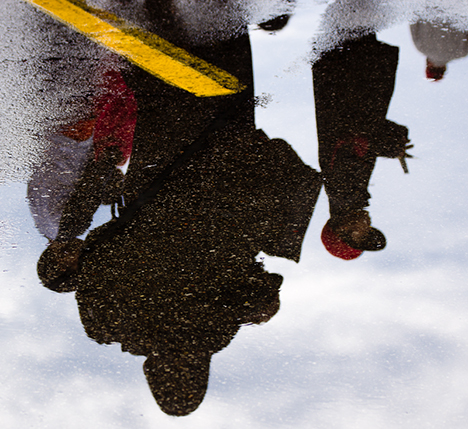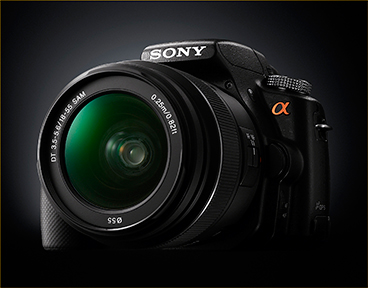
The Sony A55 has certainly created quite a buzz in the few weeks since its announcement in August. Part of the reason for this is because Sony orchestrated a very effective product launch in North America, with leading print and web journalists being invited to a three day hands-on session, with sample cameras and lenses to shoot with and Sony engineering and marketing people to ask questions of. Sony also seeded leading international camera review sites with production samples enough ahead of time so that full reviews were possible on the day of launch. (If only other companies had their product launch act as together as did Sony – at least on this occasion).
But no amount of journalist schmoozing will suffice if the product is a dud, and in this case the A55 and A33 cameras are anything but. In fact, based onmy early impressionsand those of the more technical and rigorous camera review sites, Sony has a real winner on its hands.
But a few days shooting in the pressure cooker of a press junket needs to be moderated by a bit more time of real-world use, and I have just finished two weeks of shooting with the A55 in more familiar surroundings.
This hasn’t produced any earthshaking new discoveries. I’m still as enamored of the A55 I was was initially, and I’m still as frustrated by its failings, particularly in the area of video.
____________________________________________________________________________________
The EVF
The camera’s EVF combined with its pellicle mirror will likely remain controversial until more people discover how much better it can be than the small and dim “window at the end of a tunnel”that most reduced-frame DSLRs currently offer. But, anyone coming from a full-frame camera, such as Sony’s own A900, will find the view dimmer than they might prefer. The day of theall conqueringEVF just isn’t here yet, though these are getting better all the time.
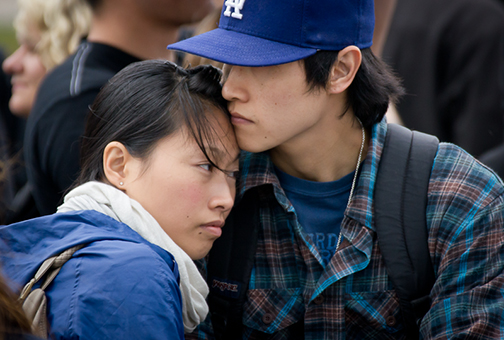
Waiting in Line. Toronto. September, 2010
Sony A55 with 70-300mm G at ISO 800
____________________________________________________________________________________
Ergonomics
The A55 is a relatively small and light camera, in large measure because it does away with the bulk of a moving mirror assembly and pentaprism through the use of its translucent mirror and an electronic viewfinder.
With the kit lens, and smaller lenses in general, the body’s compact size is most welcome. But with larger and heavier lenses, where one’s hold on the body needs to become firmer, the short grip area reduces support. With my medium-sized hands my pinky finger has nothing to hold onto, and after a while with a lens like the 70-300G (notthatbig and heavy) my right hand eventually gets fatigued.
What I would like to see is a battery grip that adds a second battery and which would augment hand-holdability with longer and heavier lenses. Given the camera’s lowish battery life (see below) this would kill two birds with one stone.
Heat
I spent one afternoon at a country fair shooting both video and stills. The ambient temperature was about 18C and it was mostly cloudy. I shot about 200 stills and some 15 minutes of video over a four hour period.
I intermittently saw on the LCD what I assume was a high temperature warning. Whether it was because of sensor heating or the use of IS during filming, I can’t say, and because I still don’t have a user manual I can’t be certain of what the orange warning symbol means.
In any event, the camera continued shooting and the symbol went away after about a 5 minute break turned off.
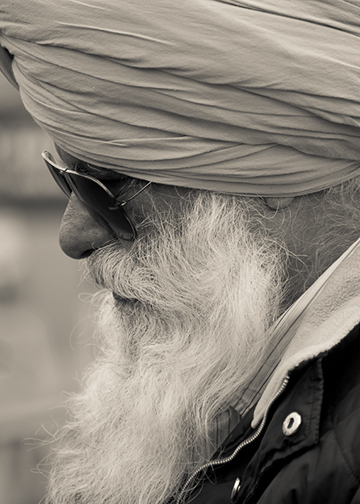
In Thought. Toronto, September, 2010
Sony A55 with 70-300mm G at ISO 800
____________________________________________________________________________________
Battery
The A55 and A33 use the same NP-FW50 model battery (1080mAh) as do the new NEX cameras. Small and light, these batteries suit the size of the camera, but simply don’t have enough juice for a full day of shooting. My recommendation is that anyone with an A55 or A33 have an extra battery, and maybe even two for long shooting days.
____________________________________________________________________________________
Ghosting
There has been chatter on the forums about ghosting being seen on some images taken with the A55. This apparently caused by the use of a pellicle mirror.
I’ve seen the online examples, but have not seen any evidence of ghosting in any of the hundreds of frames that I have shot myself, including ones where I deliberately tried to make it happen. To the extent that there is such an issue, I regard it as quite minor and of thepixel peepingvariety, and unlikely to be of issue to most photographers who aren’t micro-examining their images at 200% on-screen.
____________________________________________________________________________________
LCD Positioning
The A55 has a fully articulated LCD that is hinged at the bottom. Some folks online have worried that this means that the A55 won’t mount properly or work well on a tripod. Nonsense. All one has to do is mount the plate so that it does not extend beyond the rear of the camera and mounting isn’t an issue.
But, there is a limitation when it comes to rotating the LCD so that one can be in the shot (in front of the camera). The view of the LCD is blocked by tripod itself. I found this to be a problem with using the A55 as one of the video cameras in a three camera interview shoot, but most people won’t find it to be an issue.
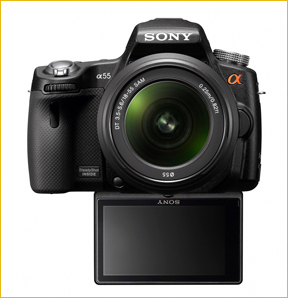
The way that the Panasonic GH1 does it, with the pivot point to the left of the camera, seems to be the preferable way of doing it.
____________________________________________________________________________________
Video
Let’s start this discussion of the A55’s video capabilities with the understanding that all video capable DSLRs are compromised. None of them are particularly good video cameras. The suffer to one extent or another from moire, aliasing, rolling shutter, and bad audio. They don’t have peaking, zebras, built-in ND filters, XLR or BNC connectors, wave form monitors, or any of the other niceties that a decent video camera has.
What they do have is the convenience of having video along with stills capability, for those times when it might be needed in a pinch, and most importantly shallow depth of field, because of their large sensors (compared to 1/3″ or 1/2″ camcorders). Good high ISO capability as well. But, while shallow DOF is what gives many video makers heart palpitations, it also makes shooting decent video really difficult.
Now add to this the fact that with most video DSLRs autofocus is going to be poor to nonexistent when shooting video, and that auto-iris is going to be discontinuous (jumpy), and you have a really difficult device to shoot video with – well.
As for the Sony A55, it has its own bag of troubles, but also an ace or two up its sleeve. One of the plusses of this camera is that it has an electronic viewfinder, so for times when one needs to shoot video at eye level, hand-held, it will deliver. The Panasonic GH1 has had one for the past 18 month.
The big news is that because of its pellicle mirror the A55 can autofocus continuously and quickly while shooting. No other video DSLR can even come close. That’s the good news.
The bad news is that it can only autofocus in fully automatic mode, with the lens set to its widest aperture, or f/3.5, whichever is smaller. To be able to set the aperture manually one has to turn autofocus off (not a big deal really for narrative type shooting, where shallow DOF is the name of the game).
But, this still doesn’t give you any real control over actual exposure because the camera wants to set the shutter speed and the ISO. Regardless of how you set things, when shooting video the A55 will not let you set either shutter or ISO. It does its best to give you an appropriate shutter speed (1/60th or so, if it can), if the light is not too bright. If it is bright, you’re SOL.
In low light it will automatically crank the ISO to 1600 to try and keep an appropriate shutter speed, but in bright light, because like all video DSLRs there’s no built-in ND filters, there’s nothing it can do other than crank up the shutter speed – which looks crappy on anything except fast action.
The answer is to use ND filters or polarizers in front of the lens to bring the exposure into the proper range. This is fussy and fiddley, but the only way to really get this camera to heel.
Is the A55 worse than other video capable DSLRs? Yes, in some ways it is. Cameras like the Canon 5D MKII and 7D, and the Panasonic GH1 (and others I’m sure) allow for full manual control when shooting video. And, not to flog an already dead horse, they also shoot 24P, which so many amateur as well as professional film makers want.
Sony’s MO is always –“We know best…” – and when it comes to video on the A55, things are no different. Sadly though, they don’t.
But, all is not doom and gloom. Video quality is quite good; comparable to others in its price class, and if fast continuous video AF is what you’re looking for the A55 delivers the goods. Add to that the terrific Zeiss A series glass that’s available (like the fantastic new Zeiss 24mm f/2), and in-body stabilization that works with any lens, and you have a strong contender.
Shot in ‘Portrait” style with Sharpening, Contrast and Saturation all set to -3.
This video was shot at 1920X1080 P/30 and reduced to 1280X720
for web display. Any artifacts seen are as a result of web compression
or transmission losses. The original video is very clean.
____________________________________________________________________________________
NEWS FLASH
As this was being written in early September a European web site has reported that Ichiro Takagi, Sony’s Deputy President of its Imaging Business Group, is quoted as saying that new firmware with enhanced manual video controls will be announced for the new NEX and Alpha cameras at Photokina in late September.
This will be most welcome news, and a sign that sometimes companies do pay attention to reviewer and customer feedback.
____________________________________________________________________________________
How to Shoot The Best Video Possible With Your A55
OK. I’ve told you all the reasons why some aspects of shooting video with the A55 suck, or at least is as difficult to use as with all other video DSLRs. But you are still interested. Good. So am I.
There are a few things that you need to do to get the best quality video possible. Here then is a short recipe book of the steps to take. This applies to the Sony A55, but also just about any other video capable DSLRs, with only minor settings differences.
– Aliasing and moire are serious problems with video DSLRs because of how manufacturers scale down the 14-24 Megapixel sensors to the 2MP needed for HD video.This articleby Barry Green at DVXuser is a must-read if you want to understand what this is all about.
There are a number of ways of combating aliasing. Using a diffusion filter is one approach. TheZeiss Softarseries is one of the best.
Another is to reduce in-camera sharpening as much as possible. Turn sharpening down to -3. As discussed below, you may also way to reduce contrast and saturation to their lowest settings as well.
– Reduce Contrast and Saturation
DSLR video is usually over the top when it comes to contrast and saturation, at least as compared to pro-level camcorders. If you want to combine video DSLR footage with that from a high-end video camera, starting off with low contrast and low saturation footage will be best. It’s much easier to boost either or both than it is to reduce them after the fact. Video is just like still JPGs in that respect – it’s fully baked, and therefore getting every aspect of exposure, colour balance and overall image quality the way you want it in-camera, will produce a much better result than trying tofix it in post.
– Set Manual Exposure, Manual Focus, Manual White Balance
Imagine shooting a series of still photographs and having your exposure slightly different between each one. Or having the white balance change between shots. Or focus shift off your main subject.
That’s exactly what can (and usually will) happen when you have your video DSLR set to its various automatic modes. But because video is a stream of 24 to 60 images per second the slightest change in ambient light, or subject, or camera motion will cause the shot to visibly change, and this is more obvious than you might think for viewers. Unless you’re shooting in a completely fluid and unpredictable situation, turn all auto functions off.
– Use Vari-ND Filters
It’s important to be able to shoot at the precise shutter speed and aperture that you need and want. To do this in a camcorder we use built-in neutral density filters. Not having these available in video DSLRs the solution is a variable neutral density filter over the lens. These can provide from about a two stop to an 8 stop reduction in light.
My recommendation is to buy the largest size that you need and then use step down rings to fit your various lenses.
– Use a Tripod
Herkey jerky camera movement can be an effective story telling tool in a vampire movie to give the feeling of the unexpected, but 99% of the time its simply amateurish and distracting.
While many video DSLRs have decent image stabilization, its no substitute for a tripod. And, since most of the shooting that you’re likely to do with such a camera is with a wide aperture you’ll likely want to be locked off at a pre-set position in any event.
– Dual System Audio
The A55 doesn’t have a particularly good audio system. It lacks any form of manual audio level control. There are a couple of Sony exterior stereo mics available but my suggestion is to use what is called Dual System audio.
Try a small pro-grade digital audio recorder. I currently use anOlympus LS10. If you’re recording dialog, such as for an interview, simply have the on-camera talent clap once, once your camcorder or video DSLR and the audio recorder are both rolling. In your editing software, display the audio wave form and simply visually line up the clap and audio peak and you’ll have perfect lip sync.
Better yet – if you edit with Final Cut Studio, for $150 you can buyPluralEyes,a plug-in which allows for automatic synchronization of multiple video and audio tracks.
Red and Yellow. Toronto, September, 2010Sony A55 with 70-300mm G at ISO 800
____________________________________________________________________________________
Going Forward
Over the years there have been only a handful of seminal cameras. The Pentax Spotmatic, Nikon F, Olympus Pen F, Leica M3, Hasselblad 500C, and Canon T90 come to mind, as do the digital Nikon D1 and Canon D30. Each incorporated either a technology, or a design feature, or a price point that made it stand out at the time, and which ensured its place in photographic equipment history.
(No need to send me other camera names. There are a great many deserving – I just selected a few that came quickly to mind.)
I believe that the Sony A55 will also be seen as belonging to this pantheon. With its 16 Megapixel 1.5X sensor with clean high ISO capability and overall image quality goodness as its core, Sony then adds solid video capability with superior autofocus tracking, 10FPS shooting, greatly improved multi-point autofocus (though occasionally a bit flaky), a high quality electronic viewfinder, and an articulated high resolution LCD.
Add to this in-body stabilization that works with all lenses, all of Sony’s current fancy shooting modes like sweep panorama, multi-shot HDR, six-frame-merging low light capability, and multi-frame noise reduction for shots up to ISO 25,600, and you have a solid (though small and light weight) picture taking machine, with as many gadgets and gizmos as anyone could want. The potential appeal of the A55 should therefore be obvious.
Oh yes, there are the 30+ Sony lenses available, not to mention the superb Alpha Zeiss lenses that leave little to ask for when it comes to optical and mechanical quality.
Did I mention that all of this comes in on the A55 at under $750?
The only real fly in the ointment is the currently crippled video mode that lacks manual settings for shutter speed and ISO. Also the camera will be of reduced interest to serious video producers without 24P mode. If Sony does, as they have indicated they might, provide manual video settings their sales will increase dramatically among those interested in video, and if they were to add 24P they’ll have to beat videographers off with a stick.
The bottom line is that one can read all the specs, reviews, and test reports that one wishes, as well as all the chatter found on on-line forums. But the proof of the pudding is in the shooting (to mix a metaphor), so if the capabilities of the A55 appeal, my suggestion is to visit a dealer or a Sony store and check one out for yourself.
I think that time and the marketplace will show the A55 to have been a pivotal camera for Sony, as it brings a lot of new technologies to bear in a well specified and well priced camera. I fully expect Sony to introduce much of what has been introduced with the A55 into higher specs models over the next couple of years.
September, 2010
You May Also Enjoy...
Sony RX1R
In late June 2013 Sony announced the Cybershot Rx1R, an extension of its spectacular and unique Rx1, introduced last year. But first, a recap. When I reviewed

